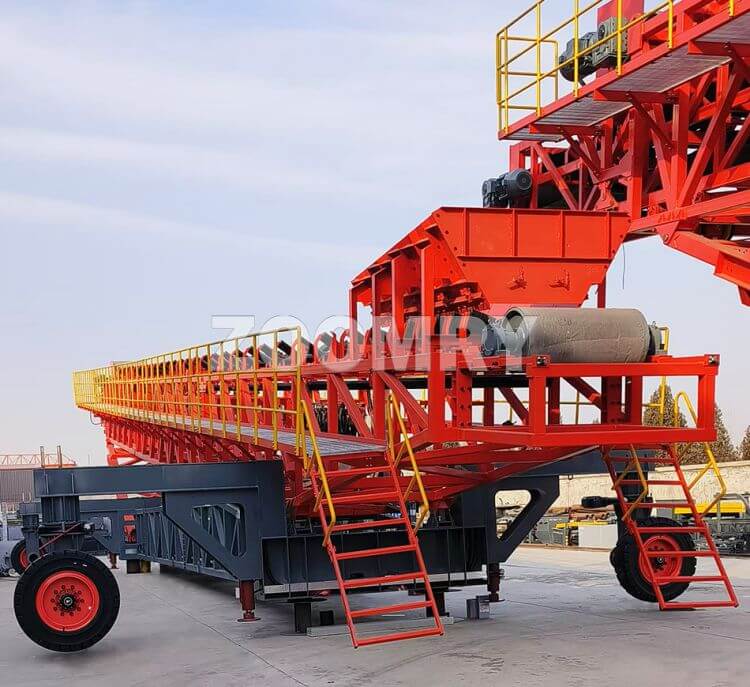According to the 2024 industry report by the International Materials Handling Association (IMH), global annual handling of bulk industrial materials has exceeded 45 billion tons, with automated conveying systems contributing 37% to efficiency improvements. In this technological evolution, stackers have become the technical hub of bulk material storage due to their modular and intelligent design—not only reducing the footprint of traditional stockyards by 40%-60% but also increasing raw material utilization to over 92% through precise material layering technology. From iron ore ports to biomass energy plants, stackers are reshaping industrial material management paradigms: their millimeter-level positioning accuracy of boom systems, handling capacity of up to 2,000 t/h, and deep integration with environmental monitoring systems mark a leap from mechanization to digitalization in bulk material handling.

Basic Functions and Technical Principles of Stackers
Core Functions of Stackers
A stacker is a specialized machine that uses mechanical arms or Conveyor Belts to stack bulk materials (such as coal, ores, grains, etc.) to specific heights and shapes. Its core functions include:
- Directional Stacking: Automatically adjusts stacking positions according to site planning, forming regular pile shapes (e.g., trapezoidal, triangular, or layered stacks).
- Classification Management: Distinguishes between different types or batches of materials through control systems for zoned stacking.
- Efficient Coordination: Can synchronize with upstream unloading equipment like truck unloaders and downstream reclaiming equipment like stacker-reclaimers to form a continuous workflow.
Working Principles and Structural Design
- Boom Conveyor Belt: Capable of horizontal rotation and pitch adjustment, covering a working radius of 30-60 meters.
- Travel Mechanism: Rail-mounted or tire-based chassis, enabling longitudinal movement along the stockyard.
- Control System: Integrates PLC (Programmable Logic Controller) and sensors for automated height adjustment, angle control, and fault alerts.
- Modular Structure: Modern stackers feature bolted truss frames. For example, Zoomry Heavy Industry's ZR160SF model's 60-meter truss can be disassembled into four standard shipping container modules, reducing on-site assembly time to 72 hours.
Technical Advantages of Stackers
Enhanced Operational Efficiency
Compared to manual stacking, stackers can handle 500-2,000 tons per hour and support 24/7 continuous operation. Their automated control systems reduce energy consumption by over 30% and eliminate human operational errors.
Adaptability to Complex Conditions
By replacing conveyor belt materials (e.g., heat-resistant rubber or anti-static coatings), stackers can handle various materials like coal, iron ore, and fertilizers.
Environmental Adaptability
The steel frame of stackers is designed using finite element analysis, withstanding wind speeds of up to 60 m/s (equivalent to a Category 17 typhoon). Specially sealed bearings and IP66-rated electrical components enable operation in coastal environments with salt mist concentrations of 3 mg/m³ for over 10,000 hours. The hydraulic system features temperature-compensating valves, ensuring precision in temperatures ranging from -30°C to 50°C.
Multi-Equipment Collaborative Technology
In modern bulk material handling systems, stackers can work with stacker-reclaimers, Mobile Ship Loaders, and truck unloaders to form a complete material flow for special environments:
Front-End Coordination Equipment
Truck unloaders feature dual hydraulic stabilizers for handling 100-ton dump trucks. Their grid-type receiving ports include automatic clog-clearing devices, maintaining a throughput of 1,800 t/h even with sticky materials containing 15% moisture. Vibratory feeders have adjustable frequencies of 0-50 Hz for uniform material supply.
Mid-End Transfer Equipment
Stacker-reclaimers' crawler chassis include slope-adaptive systems for stable operation on 15° inclines. Quick-connect mechanisms enable seamless docking with stackers, while hydraulic lifting systems allow discharge height adjustments from 3-8 meters to meet varying stacking requirements.
Terminal Output Equipment
Mobile ship loaders use wire rope dynamic compensation technology to ensure precise material discharge even with ship rolls of ±5°. Their material flow monitoring systems synchronize with ship draft data for automated load balancing, achieving loading rates of 8,400 t/h.
Maintenance and Safety Standards for Stackers
Routine Maintenance Points
- Regularly inspect conveyor belt wear and replace damaged sections promptly.
- Clean accumulated material from rollers and idlers to prevent bearing jams.
- Calibrate angle sensors to ensure boom positioning accuracy.
Safety Operation Guidelines
- Prohibit personnel from entering the boom rotation zone during operation.
- Activate emergency lock procedures during strong winds (≥Level 6) or thunderstorms.
- Equip infrared anti-collision systems to avoid clashes with other stockyard equipment.
With the acceleration of infrastructure construction in Belt and Road Initiative countries, overseas demand for efficient bulk material handling equipment continues to grow. Chinese companies like Zoomry Heavy Industry are breaking technological barriers through innovations such as hydraulic closed-loop control systems and wireless remote operation modules. In the future, stackers will evolve toward "unmanned stockyards," integrating 5G communication and digital twin technologies for full-process remote control. Contact us at: +86 131-6401-6717 | oversea@zoomry.cn

 ZOOMRY
ZOOMRY

